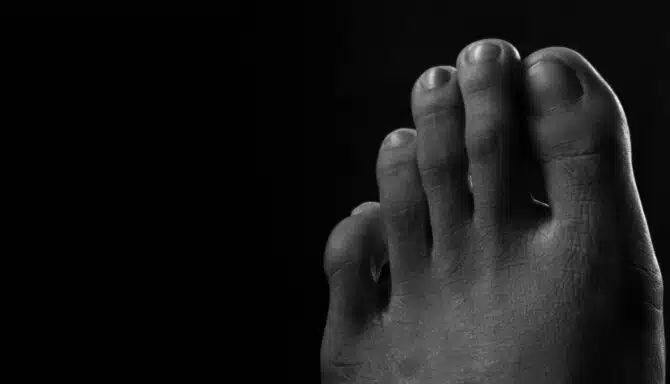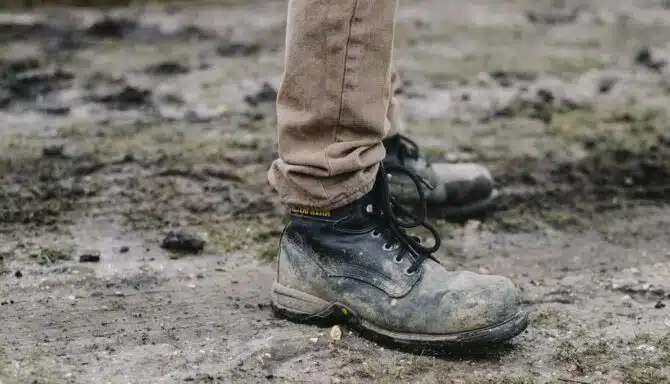Do you ever feel like you have a pebble in your shoe? Or do you experience a burning sensation in your toes? You’re likely experiencing pain in the ball of your foot.
The ball of the foot is the padded portion of the sole between the toes and the arch, underneath the heads of the metatarsal bones. Since weight is transferred from heel to toe when you walk or run, this area is prone to injury. Beyond foot conditions, you may also experience calluses and blisters in the ball of your foot as it’s an oft-used part of the foot. During the activity, if weight is unevenly transferred, pain, swelling, and foot conditions can develop over time.
The cause of ball of foot pain can be any number of foot conditions. Below you’ll find the five most common causes and ways you can reduce pain and treat ball of foot pain.
What Causes The Ball of Foot Pain?
Ball of foot pain occurs towards the front of your foot. This area consists of your metatarsals-bones of the mid-foot-and the phalanges-bones that make up the toes of the foot. In addition to pain, you may also experience burning, or tingling sensations in the area, or in your toes. It may also feel like you have a pebble in your shoe.
You might develop ball of foot pain if you participate in activities that involve running and jumping.
Metatarsalgia
Metatarsalgia is a term used for any pain found in the ball of the foot. As such, it’s often a catch-all term for a symptom of other conditions, rather than as a specific disease. The pain comes from too much pressure on one spot in your foot. Foot deformities or biomechanical deficiencies-a short first metatarsal bone or a long second metatarsal bone, prominent metatarsal heads, tight toe extensors, weak toe flexors muscles, hammertoe deformity, for example-can also contribute to metatarsalgia.
Morton’s Neuroma
Morton’s Neuroma is a type of nerve compression syndrome which involves nerves in the lesser toes. It involves fibrosis and thickening of nerve tissue between the third and fourth intermetatarsal space. Morton’s is usually a result of repetitive trauma. Morton’s Neuroma is the condition that’s most often associated with the feeling of having a pebble in your shoe.
The underlying cause can be attributed to the nerves in your feet being compressed or irritated.
Stress Fractures
Metatarsal fractures represent approximately 25 percent of stress fractures. Stress fractures are tiny cracks in a bone.
This injury is overwhelmingly due to repetitive force to the area. Sports like running, soccer, and any activity involving jumping make participants particularly susceptible to stress fractures. Especially in running, where much of the impact is absorbed by the ball of your foot, stress fractures in this area can be common. Generally, stress fractures happen in the second and third metatarsals.
Instability of the MTP Joint
Joint instability is a more complicated, less common problem. Pain is caused by the bones of the MTP joint moving too much due to loose ligaments. A metatarsal pad and joint taping may be helpful. Additionally, shoe modification, and using an insole can also help restabilize the deficiencies and abnormalities caused by joint instability.
Improper Footwear
There are other causes as well, including foot deformities and shoes that are too tight or too loose. By forcing your toes inwards and squeezing them into a small area, you put more pressure on your third and fourth toes. This pressure can aggravate the tendons, joints, and bones in the ball of your foot. For a complete foot assessment, and to be properly fitted for footwear, visit us at Feet First Clinic located at 2481 Bloor St. W. We’re Toronto’s foot care experts.
What can you do about pain in the ball of your foot?
- Change your footwear. Avoid high heels or tight shoes. Choose shoes with a broad toe box and extra depth. Get your feet properly assessed and measured to ensure your shoes fit correctly.
- Take anti-inflammatory medications. Anti-inflammatory medications, such as ibuprofen (Advil, Motrin IB, others) and naproxen (Aleve), can reduce swelling and relieve pain.
- Take a break. As the pain in the ball of the foot is often caused by repetitive impact, take a few weeks off of high-impact activity. When returning, gradually increase the intensity to ensure your body is able to keep up with the increased workload.
- Rest. Protect your foot from further injury by resting. Elevate your foot after standing or walking.
- Ice. Apply cold to the area for 10-20 minutes two to three times per day. Avoid applying ice directly to the skin, and use a towel or ice pack instead.
- Use metatarsal pads. Footpads in your shoes under the ball of your foot can help deflect stress from the painful area.
- Consider arch supports. If insoles don’t help, your doctor might recommend arch supports to minimize stress on the metatarsal bones and improve foot function. You can buy arch supports over-the-counter, or they can be custom fitted.
- Taping. Tape your MTP joint to help improve stability.
Ball of Foot Pain? We Have You Covered!
We’re confident in our ability to help inform you and solve your concern with the least amount of discomfort possible. Call us even to ask about a quick question and we’d be happy to point you in the right direction!
Call us at 416-769-3338 or Book Your Assessment Today!












